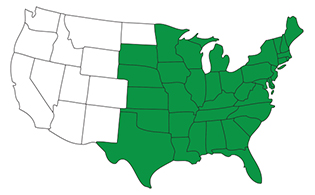
White Heath Aster
Aster pilosus
White Heath Aster is a perennial broadleaf weed that is also known as Awl-aster and Subulate-bracted Aster. Its scientific name is Aster pilosus.
Identify

Upright

Lanceolate
White Heath Aster can be identified by its clumped, vertically growing stems that are often woody at the base and branched in the upper portion. The stems are usually hairy, but sometimes smooth, and its leaves are also hairy. This broadleaf weed has fibrous roots originating at the base of the stems and survives through winter as a woody crown of stems at, or just below, the soil surface. Blooming from August through November, White Heath Aster features daisy-like flowers with one to two dozen white (sometimes pinkish-purple) ray florets surrounding numerous yellow disk florets. Reproduction occurs by seeds.
Life Cycle
This broadleaf weed prefers dry soils in disturbed areas and often grows in prairies, meadows, thin lawns, fallow fields and along roadsides and railroads. White Heath Aster thrives in most of the southern, eastern and midwestern parts of the United States.

Control
Aster pilosuscan thrive in numerous soil types and aggressively reseeds itself. This makes it a real problem for lawns and gardens and renders it immune to cultural weed control practices such as proper mowing or aeration. Professionally selected and applied broadleaf weed killers—based on your specific climate and geography—are the most effective method for control.




Facebook
X
Youtube
Copy Link
Email